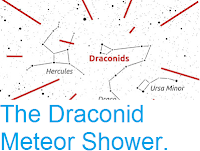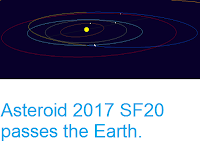Asteroid 2015 SO2 passed by the Earth at a distance of about 9 911 000
km (25.8 times the average distance between the Earth and the Moon, or 6.63% of the distance between the Earth and the Sun), slightly before 3.20 am
GMT on Saturday 30 September 2017. There was no danger of
the asteroid hitting us, though were it to do so it would have
presented a genuine threat. 2015 SO2 has an estimated
equivalent
diameter of 31-99 m (i.e. it is estimated that a spherical object
with
the same volume would be 31-99 m in diameter), and an object at the
upper end of this
size range would be predicted to be capable of
passing through the Earth's
atmosphere relatively intact, impacting the ground directly with an
explosion that would be 225 times as powerful as the
Hiroshima
bomb. Such an impact would result in an impact crater over a kilometre in
diameter
and devastation on a wide scale, as well as climatic effects that
would last years or even decades.
Image of 2015 SO2 (center of field, at intersection of lines), taken with the 60-cm, f/3.3 Cichocki telescope at Črni Vrh Observatory in western Slovenia. Blaž Mikuž/Črni Vrh Observatory.
2015 SO2 was discovered on 21 September 2015 by the Črni Vrh Observatory in western Slovenia. The designation 2015 SO2 implies that it was the 64th asteroid
(asteroid O2) discovered in the second half of September 2015 (period
2015 S).
The calculated orbit of 2015 SO2. Minor Planet Center.
2015 SO2 has a 364 day orbital period, with an elliptical orbit tilted at
an angle of 9.17° to the plain of the Solar System which takes in to
0.89 AU from the Sun (89% of the distance at which the Earth orbits the
Sun) and out to
1.11 AU (11%
further away from the Sun than the Earth). This means that close
encounters between the asteroid and Earth are fairly common, with the
last thought to have happened in September 2016 and the next predicted
in September 2018. Although it does cross the Earth's
orbit and is briefly
further from the Sun on each cycle, 2015 SO2 spends most of its time
closer to the Sun than we are, and is therefore classified as an Aten
Group Asteroid.
See also...








